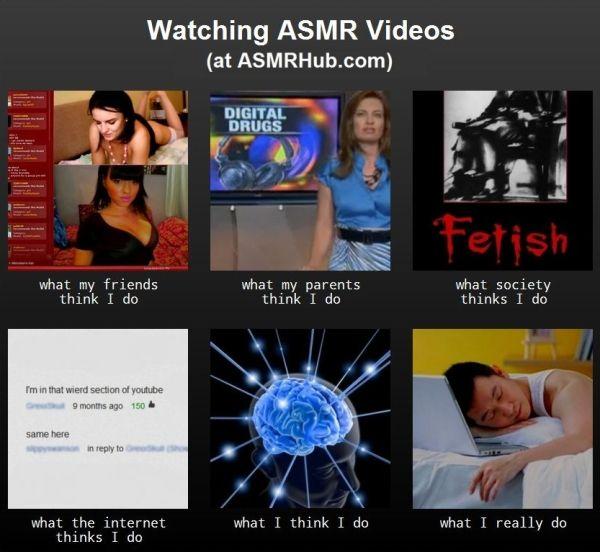
ASMRtists and the online ASMR -communities
In this article, the behavior and norms within the micro-population of ASMR lovers will be analyzed. What do you need to know and in what way do you need to act to become one of them?
Do you know what ASMR is?
Autonomous sensory meridian response (ASMR) signifies the subjective experience of low-grade euphoria characterized by a combination of positive feelings and a distinct static-like tingling sensation on the skin. Typically, it begins on the scalp and moves down the back of the neck and upper spine. It is most commonly triggered by specific auditory or visual stimuli, and less commonly by intentional attention control.
The most popular source of stimuli reported by subjects to be effective in triggering ASMR is video. Videos reported to be effective in triggering ASMR fall into two categories, identified and named by the community as intentional and unintentional.
Intentional media content is created by those known within the community as 'ASMRtists' with the purpose of triggering ASMR in viewers and listeners. To generate tingles, ASMRtists use high-sensitive microphones in combination with all kinds of products and tools to produce sounds that they call triggers. A few examples of these triggers are tapping sounds, scratching sounds, whispering or soft talking, and brushing the microphone. These are just a few of the many triggers out there.
Unintentional media content is made for other purposes, often before attention was drawn to the phenomenon in 2007, but which some subjects discover to be effective in triggering ASMR. One early unintentional example is the Art Bears song 'The Bath of Stars.' Watch the video below to get an idea of what ASMR is.
Another example of unintentional media is created by painter Bob Ross. In episodes of his popular television series 'The Joy of Painting', his soft, gentle, altruistic speaking mannerisms and the sound of him painting and of his tools trigger ASMR in many of his viewers.
In this article, I will analyze and understand the ASMR niche as a social group. More in particular, I will analyze them as a polycentric, layered, and translocal micro-population.. I will sketch a picture of what it is like to be a part of this micro-population: what does one need to know in order to become a master? Which norms are being conveyed? What does it mean to be an ASMR lover?
ASMR as a micro-population
Currently, nothing can be definitively known about ASMR since the perceptual phenomenon itself has yet to be clearly identified as having biological correlations. However, nowadays, interest in ASMR has reached a new level. People all over the world experience the sensation and turn to the Internet for answers.
Even so, the Internet, especially platforms like YouTube, has given ASMR lovers an infrastructure on which they share their passion for this sensation. This group of ASMR lovers can be seen as a global micro-population.
Maly and Varis (2015) introduced the concept micro-population. They argue that “the world has become more complex due to new kinds of migration patterns and mobilities, the influence of new communication technologies such as the Internet, as well as the neoliberal logic of consumption and commodification. Culture, as a result, is a complex translocal and polycentric affair”.
The ASMR lover is the perfect example of this, because that micro-population is translocal, polycentric, and multi-layered.
Digital ethnography of ASMRtists and -lovers
ASMR lovers communicate via digital infrastructures. In order to understand how this group functions, I have conducted digital ethnographic research. For this type of research, one analyzes the behavior of members of a social group on digital platforms. Digital ethnographic research can be defined as "watching what people do by digitally tracking them or asking them to invite us into their social media practices. Listening may involve reading, or it might involve sensing and communicating in other ways. Ethnographic writing might be replaced by video, photography or blogging" (Pink, Horst, Postill, Hjorth, Lewis & Tacchi, 2015).
I analyzed videos recorded by YouTubers who shoot ASMRvideos, or, as the ASMR community calls them, ASMRtists. I analyzed the comments made on these videos by various micro-celebrities within this micro-population. I focused on the distillation of rules and norms that are produced by the micro-celebrities.
Within the micro-population of ASMR lovers, there are many micro-celebrities. Marwick (2015) defines being a micro-celebrity "as a state of being famous to a niche group of people". The micro-celebrities in this micro-population are mainly active on YouTube. With millions of followers and subscribers they are extremely popular and influential: they know all the trends and/or set them, they have perfected the techniques, and are considered the masters of ASMR.
As mentioned earlier, the micro-population of ASMR lovers is a multi-layered one and micro-celebrities can be found on either a national or a global layer. This can be seen in almost all ASMRtists Youtube channels, even the smaller ones. For example, let us take a look at Cindy Whispers ASMR.
Cindy Whispers ASMR is a very popular ASMRtist from the Netherlands. She has over 18,000 subscribers on her YouTube channel (data collected on the 28th of December 2018). This may seem a low number, however, the micro-population of ASMR-lovers is not big in comparison to, for example, the micro-population of make-up lovers. For make-up artists, 18,000 subscribers is a low amount, since there are a lot of make-up lovers in the online world. However, since there are not many people who know and love ASMR, 18,000 subscribers is a huge amount for an ASMRtist who only functions on a national level, like Cindy Whispers ASMR.
Another example is Isabel Imagination ASMR. She, too, is a Dutch ASMRtist. However, she chose to do her YouTube videos in English. This decision made her cross the language barrier and makes her successful all over the world. Her videos are accessible to more people and she has been able to reach over 250,000 subscribers from all around the world (data collected on the 28th of December 2018). As a result, Isabel is able to work on a global level, instead of just a national one.
A third example of an ASMRtist is Maria, better known as GentleWhispering. She is a Russian woman who fled to the United States and is one of the first ASMRtists who started posting videos on YouTube. Maria works on a global level, but also posts videos in her mother tongue. She started the trend of posting ASMRvideos. Because of Maria, more and more people started their own ASMR channels and eventually also became famous ASMRtists. Maria is now one of the biggest ASMRtists with more than 1.5 million subscribers (data collected on the 28th of December 2018). She is a great influence in the online world of ASMRtists and -lovers.
ASMRtists as masters
Not only Maria, but all micro-celebrities in this ASMR niche are very influential in many ways. For example, they are extremely important for microphone brands: they can either make or break one of your products. As explained before, high sensitive microphones are necessary for recording ASMR videos, since they pick up every single sound that is made. That way the most sensitive sounds can be heard by the listener of the video. When a trendsetter, like GentleWhispering, uses a microphone to generate triggers, but isn’t happy with the outcome of the sound, their feedback will discourage other ASMRtists from buying the same microphone.
Besides that, micro-celebrities have a great impact on the people who love to watch ASMR. Since they are the masters, ASMRtists can teach the novices and set an example for the newbies. Online, they create a learning environment where novices can learn the rules for doing ASMR. They are the ones who start trends and set norms, and therefore they dominate and influence the ‘how to’ discourse.
Overall, micro-celebrities are examples for others: they have perfected their techniques and earn money while doing what they love. In addition, ASMR is known to help people with depression, anxiety, or sleeping problems. ASMRtists not only make money while doing what they love, they can have a huge impact on the life of individuals they don’t even know as well.
A polycentric micro-population
Becker (1997) describes subcultures as homogeneous groups: “Wherever some group of people have a bit of common life with a modicum of isolation from other people, a common corner in society, common problems and perhaps a couple of common enemies, there culture grows”, suggesting that these sub-groups have a common, homogeneous culture.
However, unlike subcultures, micro-populations are very polycentric. Members orient themselves towards different centers of normativity. This also applies to the micro-population of ASMR lovers: there is an overarching, common interest, which is ASMR, but there are many sub-groups within the bigger micro-population. These subgroups love different triggers, use different tools, and have different trends.
National and subnational centers can organize different genres within the ASMR lover community. The Western culture is one of the most dominant ones. Common ASMR trends can be distilled among people from America, Canada, Australia, and Europe in which the same techniques and trends apply. Many Asian ASMR lovers, by contrast, have different norms and make ASMR videos in very different ways. When searching YouTube for Asian ASMR, most videos you get are Manga videos that can almost be comprehended as porn, for an example see figure 1.

Figure 1 Asian ASMR
Most Asian ASMR videos contain a lot of mouth sounds such as microphone licking, kissing sounds, and mouth smacking sounds. When looking into the comments on these videos, a lot of them are made by ASMRlovers from the Western side of the micro-population saying that this is too much or too graphic for them.

Figure 2 Comments on Asian ASMR by people from the Western ASMR culture
Figure 2 shows that Western ASMR lovers experience Asian ASMR as porn or think it comes close to it. When searching for more Western ASMR, the suggestions I get are videos of actual people generating triggers with a microphone, see figure 3.

Figure 3 Western ASMR
Are ASMR lovers the insiders or the outsiders?
Becker (1997) also discusses the deviant group of dance musicians who are labelled as outsiders by more conventional members of the community. He describes that dance musicians experienced a strong feeling of isolation from the rest of society. Although isolation might be too strong of a word, ASMR lovers are similar to the dance musicians as described by Becker (1997) in the sense that they too feel misunderstood by people who don't experience ASMR.
Memes are an important way of connecting amongst ASMR lovers, in which the feeling of being misunderstood by others is expressed.

Figure 4 Meme that makes a distinction between insiders and outsiders
Figure 4 shows how ASMR lovers experience talking and sharing thoughts about ASMR. The meme illustrates that the only people who understand what ASMR is and what it means to watch it are other people who also watch and listen to ASMR.
As an ASMR lover, you can try to explain what it is and what it does to you, but most people outside of the micro-population won't understand it, think it is weird or some kind of fetish. This creates a distinction between insiders and outsiders of the micro-population that is called ASMR.

Figure 5 Meme made by people who don’t understand ASMR
The photo above is a meme of GentleWhispering, who was mentioned before. The text on the photo is made by people who do not get ASMR. They think ASMR has to do with sex. Therefore, they keep making jokes about ASMR.
In Outsiders (1997), Becker explains that rules and norms always create deviance. This works both ways: ASMR lovers are considered outsiders by members of conventional society, but certain rules of this micro-population make members of conventional society outsiders. Apart from rules and norms, ASMR lovers make use of slang, by which they take part in a process of self-segregation (Becker, 1997).
Slang shows you are part of a certain group. By using words non-ASMR lovers do not understand or have a different definition of, the micro-population creates outsiders. Some examples are ‘tingles’ – which means that you get the feeling that is ASMR - or ‘trigger’ – something used to make a sound with that generates tingles.
Only true ASMR lovers will understand slang and know how to use it properly. It connects them, but also creates outsiders, as it divides the ‘regular human’ from the ASMR lover. ASMR lovers are thus both outsiders and insiders; it just depends on the perspective you take.
How to become a successful ASMRtist
We have seen that the micro-population of ASMR lovers is highly polycentric and multi-layered. There are different centers of normativity and different micro-celebrities to be found on different layers.
How can one make a career (Becker, 1997) within this micro-population: how can a beginner become a master?
First of all, you need to know the norms within a center. What is good and what is bad? What is in and what is out? Which brands have good products and which ones have bad products? How sexual can your content be?
Secondly, you need to have a good technique. A lot of harsh sounds in the background of the video or failure to use a microphone show that you are still a newbie.
Thirdly, you need to be able to understand and use slang in the correct way. This is an important identity indexical and differentiates the novice from the master.
Lastly, and most importantly, you should not care about what others think of ASMR. There are so many norms and ‘how to’ discourses within this micro-population, but if you want to break them you should do it. Making ASMR videos that contain sounds that you love and want to share with the rest of the micro-population is what makes you an ASMR lover.
References
Becker, H. S. (1997). Outsiders: studies in the sociology of deviance. New York, NY: Free Press.
Maly, I. (2017). Saabism and Saabists: a digital ethnographic analysis of Saab culture. Journal of Contemporary Ethnography
Pink, S., Horst, H., Postill, J., Hjorth, L., Lewis, L. & Tacchi, J. (2015). Digital Ethnography. Principles and Practice. SAGE publication.